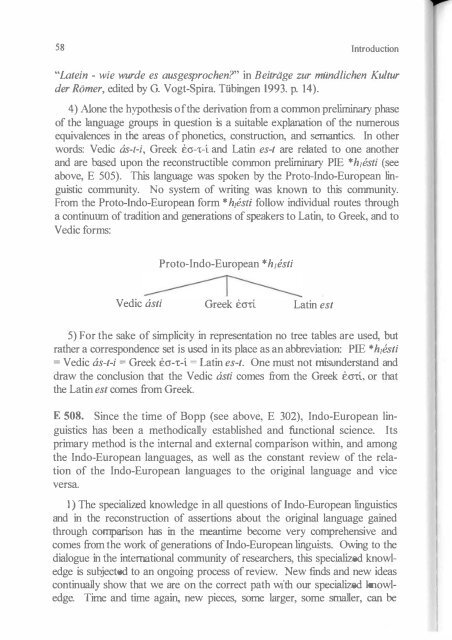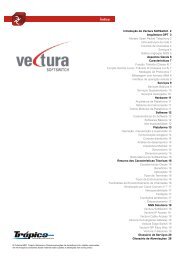You also want an ePaper? Increase the reach of your titles
YUMPU automatically turns print PDFs into web optimized ePapers that Google loves.
58 Introduction"Latein - wie wurde es ausgesprochen?" in Beitrage zur miindlichen Kulturder Romer, edited by G. Vogt-Spira. Tiibingen 1993. p. 14).4) Alone the hypothesis <strong>of</strong> the derivation from a common preliminary phase<strong>of</strong> the language groups in question is a suitable explanation <strong>of</strong> the numerousequivalences in the areas <strong>of</strong> phonetics, construction, and semantics. In otherwords: Vedic as-i-i, Greek eO"-'-1 and Latin es-t are related to one anotherand are based upon the reconstructible common preliminary PIE *h,esti (seeabove, E 505). This language was spoken by the Proto-Indo-European linguisticcommunity. No system <strong>of</strong> writing was known to this community.From the Proto-Indo-European form * h,esti follow individual routes througha continuum <strong>of</strong> tradition and generations <strong>of</strong> speakers to Latin, to Greek, and toVedic forms:Proto-Indo-European *h,estiVedic asti Greek eO"n Latin est5) For the sake <strong>of</strong> simplicity in representation no tree tables are used, butrather a correspondence set is used in its place as an abbreviation: PIE * h ,esti= Vedic as-t-i = Greek eO"-'-1 = Latin es-t. One must not misunderstand anddraw the conclusion that the Vedic asti comes from the Greek ecrn, or thatthe Latin est comes from Greek.E 508. Since the time <strong>of</strong> Bopp (see above, E 302), Indo-European linguisticshas been a methodically established and functional science. Itsprimary method is the internal and external comparison within, and amongthe Indo-European languages, as well as the constant review <strong>of</strong> the relation<strong>of</strong> the Indo-European languages to the original language and viceversa.I) The specialized knowledge in all questions <strong>of</strong> Indo-European 1inguisticsand in the reconstruction <strong>of</strong> assertions about the original language gainedthrough comparison has in the meantime become very comprehensive andcomes from the work <strong>of</strong> generations <strong>of</strong> Indo-European linguists. Owing to thedialogue in the international community <strong>of</strong> researchers, this specialized knowledgeis subjected to an ongoing process <strong>of</strong> review. New finds and new ideascontinually show that we are on the correct path with our specialized knowledge.Time and time again, new pieces, some larger, some smaller, can beThe Reconstruction <strong>of</strong> Pro to-in do-European 59added to the puzzle <strong>of</strong> Indo-European 1inguistics. It attests to the accuracy <strong>of</strong>our progress when a form that had been unclear on the hasis <strong>of</strong> earlier researchsuddenly is understood without problem.A small example from my research: The Epic Homeric verb formea81j (in aO"1tt ea81j Iliad N 543 and ::: 419) has been unclear sinceantiquity and has given occasion to untenable speculations (-7 ChantraineDELG sub voce: "rien de clair"). In another context entirely, I asked myselfone day, what the Greek equivalent <strong>of</strong> German singen is. Known tome from textbooks was the associated nominative active-voiceOJ.Li] (Epic-Poetic Greek since Homer) '(divine) voice' « *songwhti).The underlying verb is believed to be lost. (-7 Frisk GEW s. v.: "das zugrundeliegende primare Verb ist nur im Germanischen erhalten"). Anidea struck me: as an aorist, ea811 belongs to this lost verb « *e-s(lgwh_).The meaning (the word occurs in two battle scenes) fits remarkably well:"(upon him) sounded the shield." For the verbal form in question, thismeans that it was translated from the Homeric singers in the correct context,but was very early no longer understood. On the details <strong>of</strong> the explanation,see below, L 345 § l.2) Thanks to the numerous comparisons <strong>of</strong> equivalent forms we are thebest and most accurately informed in the problems <strong>of</strong> phonetics. Thus, theform <strong>of</strong> the Indo-European root * snejgwh_ is for certain correctly determined,see above E 50 I. However, while the determination <strong>of</strong> its meaning as 'tosnow' is rather certain, the question <strong>of</strong> how this relates to the Vedic meaning'to be sticky' cannot be answered with certainty. The degree <strong>of</strong> certainty <strong>of</strong>assertions varies in semantics just as it does in morphology and still more insyntax, see below S 101. Each case must be checked individually. For example,PIE *h,es- (see above E 505), <strong>of</strong> which the reconstructed 3 sg. *h,esti isquite probably the form <strong>of</strong> the original language, whereas in the I pI. *h,s-metheexact form <strong>of</strong> the present ending cannot be ascertained.E 509. The reality <strong>of</strong> the linguistic continuity <strong>of</strong> traditions from the postulatedProto-Indo-European original language to the known individualIndo-European languages <strong>of</strong> historical times cannot be doubted. To whatextent linguistic relation implies familial clan and a common genetic origin<strong>of</strong> the dispersing groups <strong>of</strong> speakers remains to be discovered. Concerningnecessary information as to the location, time and culture <strong>of</strong> this originallanguage, as well as ideas on the 'how' <strong>of</strong> the genesis <strong>of</strong> the individuallanguages, see below E 511 ff.





